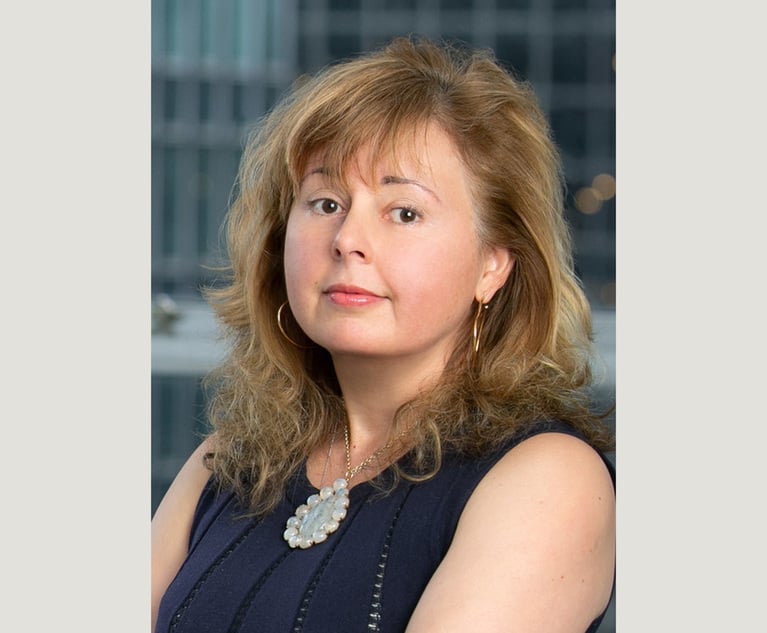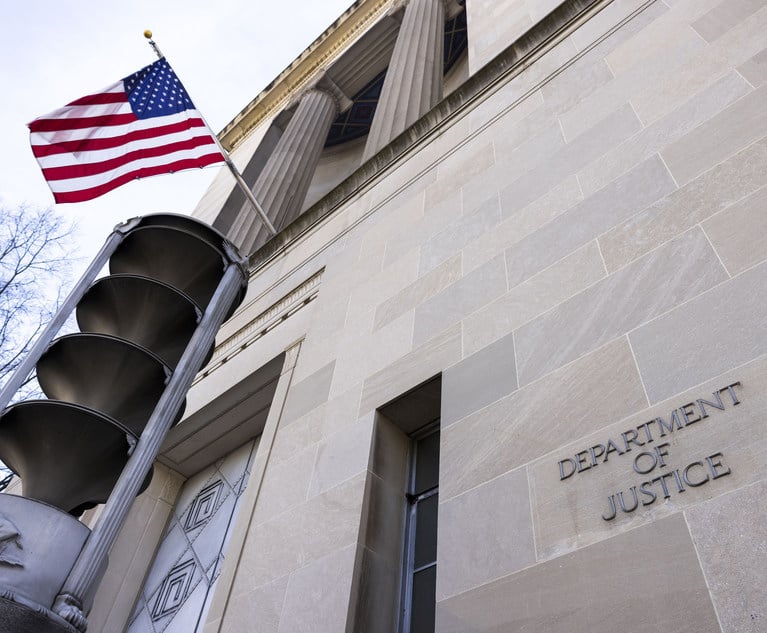 Robert J. Bernstein and Robert W. Clarida
Robert J. Bernstein and Robert W. Clarida'Stairway to Heaven' Descends on Remand
Copyright Law columnists Robert J. Bernstein and Robert W. Clarida write: The journey to final judgment has gotten decidedly longer for the rock group Led Zeppelin. On Sept. 28, 2018, the U.S. Court of Appeals for the Ninth Circuit vacated the district court judgment dismissing a claim of infringement against the band's iconic hit “Stairway to Heaven," following a jury verdict in the band's favor based on the jury's finding that the similarities between the songs did not concern copyrightable material.
November 29, 2018 at 02:45 PM
10 minute read
The journey to final judgment has gotten decidedly longer for the rock group Led Zeppelin (LZ). On Sept. 28, 2018, the U.S. Court of Appeals for the Ninth Circuit vacated the district court judgment dismissing a claim of infringement against the iconic LZ hit “Stairway to Heaven” (“Stairway”), following a jury verdict in LZ's favor based on the jury's finding that the similarities between the songs did not concern copyrightable material. Skidmore for Randy Craig Wolfe Tr. v. Led Zeppelin, 905 F.3d 1116, 1125 (9th Cir. 2018) (Skidmore). Although numerous issues were presented on appeal, the reversal was based on the Ninth Circuit's view that the case should be re-tried using jury instructions that adequately conveyed the basic principle of copyright law that an original selection, coordination or arrangement of non-copyrightable elements could be protectable even though each separate element alone could not.
The copyrightability issue centered on a chromatically descending bass line in both songs—a musical device that all parties and experts agreed was not itself copyrightable. Nevertheless, the Ninth Circuit found error in the district court's failure to make clear in its jury instructions that the relatively low level of originality required for copyright protection could potentially be found in original selection, coordination or arrangement of the descending bass line along with other elements of plaintiff's song. As a result, in a case commenced in May 2014 and tried in July 2016, the parties must now prepare for a second trial in 2019, and perhaps a return thereafter to the Ninth Circuit. Jarndyce v. Jarndyce rides again.
|Background
Plaintiff's song “Taurus” was written in 1966 by Randy Wolfe (a/k/a Randy California), a member of the rock group Spirit, and released in late 1967 or early 1968. As Wolfe died in 1997, the action was commenced by Michael Skidmore, the trustee of The Randy Craig Wolfe Trust established to administer his intellectual property. LZ was formed in 1968 by Jimmy Page, Robert Plant, John Paul Jones and John Bonham. “Stairway,” written by Jimmy Page and Robert Plant, was released in 1971 on LZ's fourth album. Plaintiff presented evidence that Spirit and LZ had played at a few of the same concerts in 1968 and 1969, although Mssrs. Page and Plant denied having heard Taurus.
The defendants included, inter alia, the group LZ, its individual members, and its music publishing and record companies. Notwithstanding the passage of several decades, the allegations of ongoing infringement enabled plaintiff to claim damages within the Copyright Act's three-year limitations period. See, e.g., Petrella v. Metro-Goldwyn Mayer, 134 S. Ct. 1962, 1967-68 (2014).
|Ninth Circuit Test for Copyright Infringement
(“… sometimes words have two meanings”)
In order to prove infringement, plaintiff must prove ownership of an original work of authorship, copying by defendant, and unlawful appropriation—that is, unauthorized taking of a material amount of protected expression. In Skidmore, and in an earlier 2018 opinion, the Ninth Circuit has now clarified that its test for copying is in line with the Second Circuit test approach, which focuses on “probative” rather than “substantial similarities”:
In cases such as this one where there is no direct evidence of copying, the plaintiff can attempt to prove it circumstantially by showing that the defendant had access to the plaintiff's work and that the two works share similarities probative of copying … . To prove copying, the similarities between the two works need not be extensive, and they need not involve protected elements of the plaintiff's work. They just need to be similarities one would not expect to arise if the two works had been created independently.
Stairway, 905 F.3d at 1125 (internal quotation marks and citations omitted) (emphasis added).
However, on the ultimate issue of infringement, i.e., “unlawful appropriation,” the Ninth Circuit continues to employ two separate and distinct tests: the “extrinsic test” and the “intrinsic test”:
To determine whether an allegedly infringing work is substantially similar to the original work, we employ the extrinsic and intrinsic tests. The extrinsic test is an objective comparison of protected areas of a work. This is accomplished by “breaking the works down into their constituent elements, and comparing those elements” to determine whether they are substantially similar … . Only elements that are protected by copyright are compared under the extrinsic test … . The intrinsic test is concerned with a subjective comparison of the works, as it asks “whether the ordinary, reasonable person would find the total concept and feel of the works to be substantially similar.”
Id. (internal quotation marks and citations omitted) (emphasis added). By way of contrast (and less confusingly), on the ultimate issue of unlawful appropriation, the Second Circuit test utilizes the term “substantial similarity” only once, asking whether there is a “substantial similarity” of protected expression between the parties' works.
In Skidmore, applying Ninth Circuit law as interpreted by the district court in its instructions, the jury returned a verdict for LZ based only on its application of the “extrinsic test.” Thus, the focus of the jury was on whether the similarities it found concerned elements protected by copyright. On this point, after considering both sides' experts, the jury determined that the similarities did not relate to protected expression, and therefore returned a verdict for LZ without reaching the question of “substantial similarity” under the “intrinsic test.”
|Conflicting Expert Testimony
(“… and if you listen very hard …”)
Among the prominent features of both “Taurus” and “Stairway” is a chromatically descending bass line underlying the harmonic structure of a portion of each song. In their musicological reports submitted in connection with a motion for summary judgment, the parties' experts set forth their views on the significance of this similarity. LZ's expert, Dr. Lawrence Ferrara, opined:
The similarities between “Taurus” and “Stairway” are limited to three measures in “Stairway” (around 9 seconds in the “Stairway” sound recording) that are iterated six times in “Stairway” for a total of 18 measures. Most of the notes in these repeating measures in “Stairway” are different from “Taurus”, and the similarity is merely result of a commonplace descending scale of pitches, a fundamental musical building block widely used in chord progressions in popular music prior to “Taurus”, used in classical music as early as the 17th century, and so common that they are sometimes referred to as a “minor line cliché”.
(Report of Lawrence Ferrara, Ph.D., Exhibit 1, ¶ 7, to Ferrara Decl., Docket No. 97-6, filed 2/25/16, in 15-cv-03462-RCK-AGR). As examples of popular songs with similar chromatically descending chord progressions, Dr. Ferrara cited, inter alia, “Michelle,” “My Funny Valentine,” and “Cry Me A River.”
Although plaintiff's expert, Dr. Alexander Stewart, acknowledged that a descending chromatic scale was a common element of chord progressions in popular music, he opined:
The underlying harmonic structure [of both songs] contains a descending chromatic bass line. While a related structure has a long history in Western music (sometimes referred to as the “Lament” ground bass), many composers through the ages have found original and creative ways to use this foundational pattern. The setting of the passage in [“Taurus”] is exemplar of such creativity and contains original musical expression. By way of comparison I would note as one example that many thousands of songs have been set to twelve-bar blues. Substantial and original expression contained therein remains protectable despite this commonality … . [B]oth “Taurus” and [“Stairway”]depart from the traditional sequence in similar and significant ways.
(Report of Alexander Stewart, Ph.D., Exhibit 2, ¶ 8, to Docket No. 97-6, filed 2/25/16, in 15-cv-03462-RCK-AGR).
|Jury Instructions and Ninth Circuit Remand
(“ … the piper will lead us to reason”)
On appeal, the Ninth Circuit held that the district court's jury instructions on the originality requirement for copyright protection were erroneous in three respects: (1) by not including a separate instruction stating that an original selection and arrangement of non-protectable elements is sufficient for copyright protection; (2) by not including a statement that originality could be found in the manner in which public domain elements, such as “descending chromatic scales,” are combined with other elements of a song; and (3) by not including a statement that “the 'original' part of work need not be new or novel.”
Observing that “[c]opyright extends to parts of a work created (1) independently, i.e., not copied from another's work and (2) which contain minimal creativity,” the Ninth Circuit concluded that these errors were not harmless and that they compounded each other:
Jury Instruction Nos. 16 and 20 in combination likely led the jury to believe that public domain elements—such as a chromatic scale or a series of three notes—were not protectable, even where there was a modification or selection and arrangement that may have rendered them original. Skidmore's expert testified that “Taurus” contained certain public domain elements—such as chromatic scales—that were modified in an original way, but the jury instructions as a whole likely would have led the jury to believe that such evidence could not establish the basis of a cognizable copyright claim. Similarly, the instructions undermined Skidmore's expert's testimony that “Taurus” and “Stairway to Heaven” were similar because of the combination of otherwise unprotectable elements.
Id., at 1129-30. As a result, the Ninth Circuit vacated the judgment based on the jury's verdict of lack of extrinsic similarity and remanded for a new jury trial with corrected instructions.
|Conclusion
(“And as we wind on down the road …”)
It remains to be seen whether a new jury, newly instructed, would come to a different conclusion on extrinsic similarity. The Ninth Circuit carefully avoided expressing any opinion on this point. It may be that a second jury, properly instructed, would still be persuaded that the similarities between the two songs do not relate to copyrightable expression, but instead arise from the use in each song of public domain elements that are not selected or arranged in an original manner. The authors express no view on this point, as they have not had the benefit of observing the expert testimony. And, of course, the first trial jury did not render a verdict on the ultimate issue of unlawful appropriation under the Ninth Circuit “intrinsic test”: “whether the ordinary, reasonable person would find the total concept and feel of the works to be substantially similar.” So there remain many steps to traverse for all concerned.
Robert J. Bernstein practices law in The Law Office of Robert J. Bernstein. Robert W. Clarida is a partner at Reitler, Kailas & Rosenblatt and the author of the treatise Copyright Law Deskbook (BNA). Italicized lines of text after section headings are quotes from the lyrics of “Stairway to Heaven.”
This content has been archived. It is available through our partners, LexisNexis® and Bloomberg Law.
To view this content, please continue to their sites.
Not a Lexis Subscriber?
Subscribe Now
Not a Bloomberg Law Subscriber?
Subscribe Now
NOT FOR REPRINT
© 2024 ALM Global, LLC, All Rights Reserved. Request academic re-use from www.copyright.com. All other uses, submit a request to [email protected]. For more information visit Asset & Logo Licensing.
You Might Like
View All
'So Many Firms' Have Yet to Announce Associate Bonuses, Underlining Big Law's Uneven Approach
5 minute read
Tik Tok’s ‘Blackout Challenge’ Confronts the Limits of CDA Section 230 Immunity
6 minute read
Enemy of the State: Foreign Sovereign Immunity and Criminal Prosecutions after ‘Halkbank’
10 minute read
Government Attorneys Are Flooding the Job Market, But Is There Room in Big Law?
4 minute readTrending Stories
- 1Call for Nominations: Elite Trial Lawyers 2025
- 2Senate Judiciary Dems Release Report on Supreme Court Ethics
- 3Senate Confirms Last 2 of Biden's California Judicial Nominees
- 4Morrison & Foerster Doles Out Year-End and Special Bonuses, Raises Base Compensation for Associates
- 5Tom Girardi to Surrender to Federal Authorities on Jan. 7
Who Got The Work
Michael G. Bongiorno, Andrew Scott Dulberg and Elizabeth E. Driscoll from Wilmer Cutler Pickering Hale and Dorr have stepped in to represent Symbotic Inc., an A.I.-enabled technology platform that focuses on increasing supply chain efficiency, and other defendants in a pending shareholder derivative lawsuit. The case, filed Oct. 2 in Massachusetts District Court by the Brown Law Firm on behalf of Stephen Austen, accuses certain officers and directors of misleading investors in regard to Symbotic's potential for margin growth by failing to disclose that the company was not equipped to timely deploy its systems or manage expenses through project delays. The case, assigned to U.S. District Judge Nathaniel M. Gorton, is 1:24-cv-12522, Austen v. Cohen et al.
Who Got The Work
Edmund Polubinski and Marie Killmond of Davis Polk & Wardwell have entered appearances for data platform software development company MongoDB and other defendants in a pending shareholder derivative lawsuit. The action, filed Oct. 7 in New York Southern District Court by the Brown Law Firm, accuses the company's directors and/or officers of falsely expressing confidence in the company’s restructuring of its sales incentive plan and downplaying the severity of decreases in its upfront commitments. The case is 1:24-cv-07594, Roy v. Ittycheria et al.
Who Got The Work
Amy O. Bruchs and Kurt F. Ellison of Michael Best & Friedrich have entered appearances for Epic Systems Corp. in a pending employment discrimination lawsuit. The suit was filed Sept. 7 in Wisconsin Western District Court by Levine Eisberner LLC and Siri & Glimstad on behalf of a project manager who claims that he was wrongfully terminated after applying for a religious exemption to the defendant's COVID-19 vaccine mandate. The case, assigned to U.S. Magistrate Judge Anita Marie Boor, is 3:24-cv-00630, Secker, Nathan v. Epic Systems Corporation.
Who Got The Work
David X. Sullivan, Thomas J. Finn and Gregory A. Hall from McCarter & English have entered appearances for Sunrun Installation Services in a pending civil rights lawsuit. The complaint was filed Sept. 4 in Connecticut District Court by attorney Robert M. Berke on behalf of former employee George Edward Steins, who was arrested and charged with employing an unregistered home improvement salesperson. The complaint alleges that had Sunrun informed the Connecticut Department of Consumer Protection that the plaintiff's employment had ended in 2017 and that he no longer held Sunrun's home improvement contractor license, he would not have been hit with charges, which were dismissed in May 2024. The case, assigned to U.S. District Judge Jeffrey A. Meyer, is 3:24-cv-01423, Steins v. Sunrun, Inc. et al.
Who Got The Work
Greenberg Traurig shareholder Joshua L. Raskin has entered an appearance for boohoo.com UK Ltd. in a pending patent infringement lawsuit. The suit, filed Sept. 3 in Texas Eastern District Court by Rozier Hardt McDonough on behalf of Alto Dynamics, asserts five patents related to an online shopping platform. The case, assigned to U.S. District Judge Rodney Gilstrap, is 2:24-cv-00719, Alto Dynamics, LLC v. boohoo.com UK Limited.






